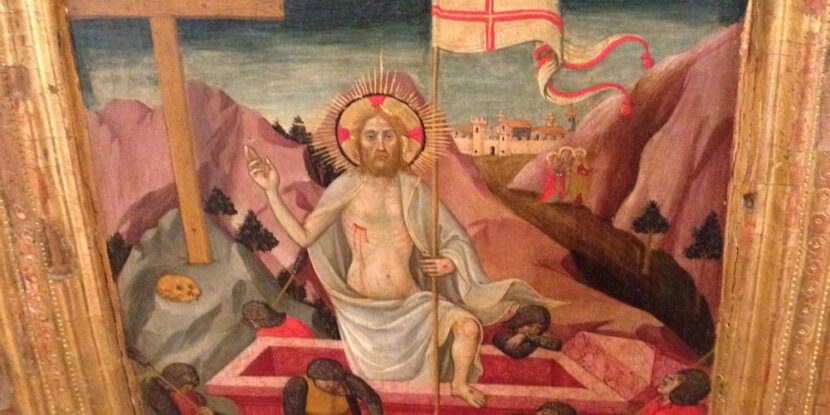With the supernatural triumph of Black Saturday, after the very human tragedy of Good Friday, Holy Week came to a close. Now, we enter Eastertide with Easter Sunday – the holiest and most important date in the Christian calendar.
Christ, true man and true God, has already died for our sins, and having done so conquered death, and rescued “the spirits in prison” from the grave. Now, He fulfills His promise to the chief priests and elders – “Destroy this temple, and in three days I will raise it up.”
He was not referring to the earthly temple of Jerusalem – doomed to destruction within a few years of His death and resurrection, in fulfillment of another prophecy – but to His own earthly body, in which, as St. John tells us, “the Word was made flesh, and dwelt among us.”
HE IS NOT HERE.
It was Mary, the mother of Jesus, Mary Magdalene, and other women who loved Jesus who would be the first to discover what had happened. Travelling to the sealed tomb where He lay – so they believed – they found the seal broken, and the great stone rolled away.
In His place, they found two angels in shining garments, who asked them, “Why do you seek the living among the dead? He is not here, but is risen!”
St. Paul, writing his Epistle to the Corinthians just a few years after the resurrection, tells us the risen Christ was seen by St. Peter, by the rest of the apostles, and by “over five hundred brethren at once,” most of whom were, at the time of writing, still alive.
Last of all he appeared to St. Paul – then Saul of Tarsus, a Jewish zealot and great persecutor of the first Christians – on the road to Damascus.
He, like the others, proclaimed from then on that Jesus was and is risen, not only in the Holy Land and not only to the Jews, but to all the world.
JESUS CHRIST ALONE.
Down to this day, of course, there are those who find the Easter story too incredible to believe. Some even suggest the Christian faith was, in essence, fabricated by the Roman authorities, to unite a fractious empire.
But why on earth would the Romans choose for this task an alien faith, persecuted from its inception not just by the Roman state, but by the relgious leaders in Israel, from whence it came?
How did St. Paul and the early saints persuade so many to turn their backs on the local gods and religious customs of countless generations, and embrace a savior who offered neither status nor wealth, but a grisly end in the colosseum?
Only Mohammed and his successors, over 600 years later, would come close to achieving a transformation of people’s traditional beliefs on a similar scale – though even in Arabia itself they could do so only at the point of the sword, and while adapting the message of Christ, Whom they acknowledged as a prophet, to their own ends.
This distinction would be recognized over a thousand years later by, of all people, Napoleon Bonaparte, himself the apotheosis of one of the most aggressively atheistic and secularizing regimes in history.
“I know men, and I tell you Jesus Christ was not a man,” he said in his final days on St. Helena.
“Superficial minds see a resemblance between Christ and the founders of empires and the gods of other religions. That resemblance does not exist. There is between Christianity and other religions the distance of infinity,” he explained.
“Alexander, Caesar, Charlemagne and myself founded empires. But on what did we rest the creations of our genius? Upon sheer force. Jesus Christ alone founded His empire upon love; and at this hour millions of men will die for Him.”
Perhaps there is a simple answer to how He managed this unprecedented feat after all.
Perhaps the story of Easter really is true.


